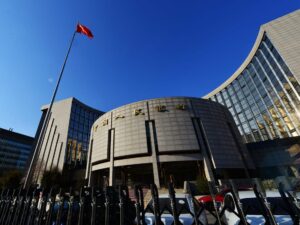>>REAL-TIME UPDATES IN THE WIRE. CLICK HERE<<<
The People’s Bank of China (PBOC) on Monday raised the risk reserve ratio for financial institutions’ foreign exchange forward sales from current 0 to 20%, effective from Wednesday.
The move is aimed to “stabilize expectations in the foreign exchange market and strengthen macro prudential management,” the central bank said in a statement on Monday morning.
By increasing the cost of foreign exchange forwards trading by banks, the move is expected to reduce the demand for foreign exchange forward purchases in the market.
The move came amid the Chinese yuan’s sharp depreciation against the US dollar which hit the strongest level in 20 years driven by aggressive rate hikes by the Federal Reserve. Last time the central bank had adjusted the forex risk reserve was in October 2020 when the ratio was cut to zero from 20% in October 2020 to curb the yuan’s sharp strengthening.
The PBOC’s move to raise the risk reserve ratio sent a strong signal of the authority’s intention to stabilize the yuan’s exchange rates and to keep market expectations stable amid the recent market volatility, Guan Tao, BOC International’s global chief economist and former official at the State Administration of Foreign Exchanges.
It could promote the balance between supply and demand in the foreign exchange market, and avoid excessive “pro-cyclical behaviour” and a “herding effect” among enterprises, Guan noted.
“This could stem further forward positions that have been negative for the yuan and slow its depreciation pace,” analysts at Maybank said in a note.
The risk reserves from financial institutions will be held by the central bank for one year without interest and if calculated based on one-year Libor of 4.83%, the implicit cost for companies’ foreign exchange forward sales will increase by about 700 basis point, said some analysts.
On the same day, the central bank slashed the yuan’s daily fixing by 378 pips to 7.0298 against the US dollar, the weakest level since May 2020 and the biggest one-day cut since June 2022.
The official daily fixing limits the onshore yuan to trade in a narrow range of 2% above or below, and Monday’s guidance kept the range to between 6.8892 and 7.1704.
The onshore yuan closed domestic trading session at 7.1464 per US dollar, weakening by 360 pips from the previous trading day, the weakest level since May 25, 2020. Notably, the onshore yuan hit an intraday low of 7.1690, 14 pips away from the lower end of the trading band.
Since March this year, the yuan has depreciated more than 10% against the US dollar and in particular, the yuan weakened by about 6% since August. The onshore yuan jumped about 7 per dollar mark on September 16 and has been above the psychologically important level for seven consecutive trading days.
Market participants believe more policy actions will be rolled out should the yuan’s weakness persist.
“Given the weak CNY level, it is likely that the PBOC will roll out measures to remove the market’s one-side depreciation of CNY against the U.S. dollar in the near term,” said Li Lin, head of global markets research for Asia at MUFG Bank.
Li expects further cuts to the amount of foreign exchange banks must hold as reserve, after a reduction earlier this month.

